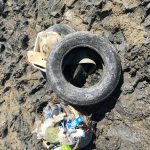 According to an article published on March 29, 2018, by Jason Bittel, the United States produces over two million tons of tire particles each year, and we still know very little about what they do to the environment. A similar study in the UK in 2017 showed that up to 30% of plastic released into the oceans each year comes from primary microplastics, not the disintegration of larger pieces.
According to an article published on March 29, 2018, by Jason Bittel, the United States produces over two million tons of tire particles each year, and we still know very little about what they do to the environment. A similar study in the UK in 2017 showed that up to 30% of plastic released into the oceans each year comes from primary microplastics, not the disintegration of larger pieces.
John Weinstein, an environmental toxicologist at the Citadel was quoted saying “Over the lifetime of a tire, about 30 percent of it wears down and is deposited on the roadway surface or in adjacent areas as microscopic particles. Every year in the U.S., it has been estimated that two million tons of tire particles are released into the environment.”
Tire particles are microplastic, which is something people have become increasingly aware of as a form of pollution. Microplastics are bits of plastic smaller than five millimeters, the approximate size of a pencil eraser.
Some European scientists report between 15% and 31% of plastic pollution came from primary microplastics, of which the biggest contributors (almost two-thirds) were abrasion of synthetic textiles while washing, and abrasion of tires while driving.
Studies have found that microplastics alter genes in Japanese rice fish, affect reproduction in oysters, and make shore crabs lethargic. Depending on the shape, size, and make-up, microplastics have even been found to kill the daggerblade grass shrimp that eat them.
But tire particles have gone almost completely unstudied, even though a recent investigation estimated that they could make up as much as 10 percent of all plastic litter worldwide. In some places, it’s much worse. “Interestingly, in Charleston Harbor, we have found that tire particles make up more than 90 percent of the microplastic litter at some of our sampling sites,” said Weinstein.
The threat of tire trash is quite similar to that of other microplastics, animals eat it and it gets stuck in their gills or digestive systems. The grass shrimp that Weinstein’s lab is studying are foragers in the wild, so they’re accustomed to grabbing up everything they can find that might have algae growing on it. In the lab, they do the same thing with tire particles, which you can see clearly as day through their translucent carapaces.
Scientists have found evidence that when crabs eat mussels, they can absorb microplastics that the mussels have eaten. Microplastics have also been found in the guts of various fish species, from flounder and mullet to sea trout and whiting. And multiple studies have shown that nanoplastics can pass through the digestive system into an animal’s tissues.
In parts of the world, such as North America, primary microplastics are a bigger source of marine plastic pollution than plastic waste, according to the report.
Synthetic textiles are the main source of primary microplastics in Asia and tires dominate in the Americas, Europe, and Central Asia.
Considering that very few people are studying this extremely widespread phenomenon, and the public has virtually no idea that it’s even an issue, awareness is probably more important than anything else at this point.
Please visit our Support page to help us continue our mission or Volunteer to clean up our critical coastal habitats and make a real environmental difference.
